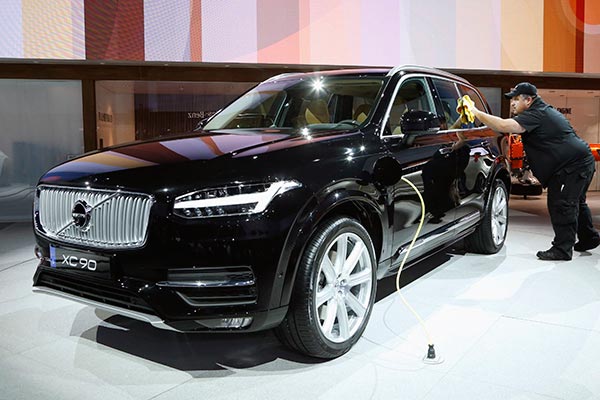 |
|
A worker polishes the 2016 Volvo XC90 at the Los Angeles Auto Show in Los Angeles, California Nov 19, 2014. [Photo / Agencies] |
The secret to Volvo's success in China's increasingly fierce premium car market is "being ourselves", according to one of the company's senior executives.
"We have respect for what ABB and other brands are doing, but we are different," said Alain Visser, the Sweden-headquartered automaker's senior vice-president for marketing, sales and customer service.
"We have the incredibly large advantage that we are the only Scandinavian brand in the world. And we will use it in a unique way, by utilizing Scandinavian strengths such as technology, innovation, design and safety."
Citing the example of the all new XC 90, which is making its Asian premiere at the Guangzhou auto show, he says "other manufacturers use many, many buttons to show their technology, but we choose to have eight and make it simple".
"In a market when everybody wants to shout the loudest, we will not shout the loudest; we shout different," he added.
This differentiation has helped Volvo win the hearts of many people; while China's premium car segment is growing at a rate of 20 percent, Volvo Car Group's sales are growing at 36 percent.
Volvo expects its sales in China to reach 80,000 units this year, up from 61,000 last year, and plans to scale up the figure to 200,000 in coming years, a quarter of its sales goal worldwide.
Visser said that growth will depend on a number of things, but first of all new products.
Speaking of the all new XC 90 that rolled off the assembly line in Sweden about three months ago, Visser said this first product based on its own Scalable Product Architecture will be one of the oldest models in Volvo's portfolio within four years.
Although he did not give a detailed list of forthcoming models, he confirmed that the second model based on its new architecture will be a large luxury sedan and it will be produced at Volvo's Daqing plant in Northeast China's Heilongjiang province, another sign of Volvo's localization strategy.
Since the debut of the S60L, its first locally made model in late 2013, Volvo now has three models in production in China, with the other two being XC 60 and XC Classic.
"For us China production is Volvo production. That means the quality standards of our cars produced in Chengdu or Daqing are identical to those produced in Sweden or Belgium," said Visser.
The plants are not only producing cars sold in China, but also those sold in other markets, the United States among others.
"We showed the model to our dealers there and they liked it," said Visser.
Visser said introducing new models such as the S60L is part of Volvo's plan to revive its performance in the US, where its sales have been declining for years.
But increasing sales in the US will take more than products, he added.
"We will reestablish the brand in the US and strengthen the dealership network," he said.
The US is expected to contribute 13 percent, or 100,000 units, of Volvo's global sales target of 800,000 units. At the moment Volvo sells about 60,000 cars a year in the US.
Volvo also showcased its plug-in hybrid S60L as well as an experimental-phase solar pavilion at the Guangzhou auto show, which Visser said is a symbol of how seriously Volvo believes in the potential of new-energy vehicles in and beyond China.
As its China sales surges, Volvo is planning to expand its dealership network in the country to cover more smaller-tier cities "because those are where we have the biggest growth potential".
